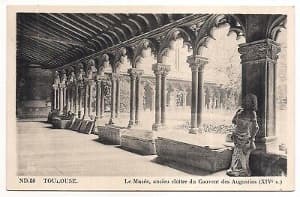History of the Augustinian Order

From hermits to mendicants
In the eleventh and twelfth centuries, many monks lived in remote places throughout Europe, but especially in Italy, in so-called eremitages. Small groups of monks lived in closed settlements, sometimes even in caves. One of the most famous was the Eremitage of Lecceto near Siena. The protest against an easy and unevangelical lifestyle, and the desire for a deeper spiritual life, was the basis for the creation of these small settlements. In the thirteenth century, the lifestyle of the hermits no longer met the needs of the surrounding world, which required a new monastic form of life.
The social and cultural landscape was greatly changed by the growth of trade, the rise of capitalism, the development of cities, the emergence of the bourgeoisie as a social power and the foundation of universities. Monastic theology had become scholastic theology. While intellectual education had been the domain of the clergy for centuries, it now passed into the hands of laity. In this climate, a large number of movements of voluntary poverty emerged, which adopted a critical attitude towards worldly life in the church. These movements formed the basis for the creation of the mendicant orders: Franciscans, Dominicans, Carmelites and Augustinians. The church needed them to cope with the new mentality. For that reason, several contemplative groups of hermits also wished to be united in a legal entity. Many of them followed Augustine's Rule. Thus the Order of the Eremites of Saint Augustine came into being, in March 1244 on a small scale, and in 1256 in a larger union approved by Pope Alexander IV. From that moment on they were mainly occupied with work in the cities.
As with most medieval religious orders, we can distinguish five periods.

1244-1350: Period of maturation and progress
Around the date of the great union, 1256, the Augustinian order spread very quickly from Italy to France, England, Germany and Spain. From these centers it spread across Europe: from Hungary and Poland to Portugal, from Ireland to the Aegean Sea, Crete, Corfu, Cyprus and Rhodes, with some settlements in the Balkans, Ukraine and the Baltic countries. As early as 1293, the Augustinians in Paris owned a convent located on what is now called Quai des Grands Augustins. This convent became an important study center. In 1329 there were thirty-four provinces. The expansion continued until 1350, although there were already traces of weakening here and there.

1350-1538: Decline and observant movements
The zeal for the evangelical life and the commitment to life in community waned. The outbreak of the plague, the Black Death, turned the entire thinking and actions of society at the time upside down. It is estimated that one-third of the population died from it, leaving entire cities, including convents, depopulated. Between 1348 and 1351 the order lost 5,084 members to the Black Death.
There are several reasons for the decline in the strength of the religious orders: weak theological education, weakening of ecclesiastical authority, the gap between higher and lower clergy. In response to widespread spiritual laxity, reform movements emerged in various places within religious orders, especially in the late Middle Ages. Many religious were homesick for the old eremitic lifestyle. The reforms were accompanied by serious tensions between observants, the advocates of innovation, and conventuals, the advocates of the old ways. It usually meant that convents that pursued a more observant lifestyle were placed in their own congregation within the order, but directly under the authority of the general. One of these reformed congregations was the Congregation of Saxony (1438) to which the convent of Martin Luther belonged, the founder of the great German Reformation. Convents in the Low Countries also belonged to this congregation. The order suffered greatly from the consequences of the Reformation. The Augustinian convents in Germany, Belgium and the Netherlands were strongly influenced by the Saxon reform. Many friars sided with Luther. As early as 1523 in Brussels, two Belgian Augustinians, followers of Luther's teachings, were burned at the stake as the first martyrs of the Reformation. The Calvinists did the same a few decades later in Ghent with Augustinians who refused to renounce their faith.

1539-1785: the Golden Ages
In various areas in Europe, such as England, the Republic and various German principalities, order virtually disappears. This period begins with the choice of Girolamo Seripando as general of the order. He was a member of an observant congregation and laid a solid foundation for a renewal of discipline and spiritual life. As a renowned scholar, he led the work of the third period of the Council of Trent (1562) to show that Martin Luther's former confreres were cut out for work in the church.

During this time period, even more reformed congregations sprang to life. The Augustinian Recollects (O.A.R.) wanted to live a stricter and more contemplative life. They founded their first house in Spain in 1589 and from 1621 they formed a congregation within the order of Saint Augustine. Only in 1912 did they become an independent order. The Discalced Augustinians (O.A.D.) also wanted a stricter form of life in Italy. They emerged in 1593 and only became an autonomous order in 1931. In France, the Discalced Augustinians were present from 1596 and disappeared with the French Revolution in 1790. The congregation of Bourges, the so-called Petits Augustins, founded in 1592 by Etienne Rabache was there is also one in the stricter direction. What also contributed to the expansion of the order was the discovery of the new world. Convents were established in Mexico, Peru, Bolivia, Ecuador, Colombia, Venezuela and Chile. Missionaries reached the Philippines and Japan. The order flourishes again and also focuses on education. By 1753 the order had approximately 1,500 convents and 20,000 members.

1786 -1880: Time of Trial and Destruction
The development of the ideas of the Enlightenment and thus the emergence of an anti-monastic climate and the French Revolution had disastrous consequences for religious life in Europe. Contemplative orders were simply regarded as socially useless. The fact that a large part of the agricultural land was owned by relatively small communities contributed to this. This view initially applied to the contemplative orders, but soon also extended to the active orders and congregations. A wave of repression began under King Louis In 1769 the Augustinians were called together in connection with the abolition of houses, and in 1773 sixty-nine houses were closed. The closures reached a peak during the French Revolution (1789-1801, with consequences until 1811). Closure meant: the confiscation of all church property, the dissolution of religious orders and congregations, and an official ban on taking vows because they were considered against human rights.
The French Revolution was not an isolated event, because the religious also suffered from systematic oppression under the Austrian Emperor Joseph II in 1782. Only outside Europe, in the Augustinian provinces of the Philippines and the United States (founded in 1796), the consequences of the revolution were not felt. During the 19th century, the government also pursued anti-religious policies in other countries such as Spain and Italy. The province of Malta was founded in 1817. During this period, brothers also went to Australia and Augustinians returned to China. The number of Augustinians had fallen to 150 convents and 700 members around the middle of the 19th century.

1881-now: Difficult recovery and crisis
A hallmark of this period is the fact that the order's governance became increasingly international and encompassed more continents, especially Africa.
A change in politics gave the order the opportunity to grow again in the countries where it was previously oppressed. Only in France did the Augustinian presence, despite several attempts, not lead to a lasting presence. Several universities were founded by the Augustinians, there was a strong focus on education and the scientific side also took off. Augustine as a spiritual source of the order was rediscovered and scientific research into Augustine's work and his spirituality in particular would become one of the characteristics of the order. By opening up previously unknown areas and by the colonization of the world by European countries, many more areas became eligible for apostolate. For example, the Belgian province started a mission in Congo and the Dutch province started missions in Bolivia, Dutch New Guinea and France. The order shared in the growth that characterized religious life until the mid-1960s.

From the 1960s onwards, the number of newly admitted brothers fell sharply and the number of brothers who left rose. This meant a thorough reflection on one's own spirituality, apostolate and one's position in church and society. The order's attention increasingly shifted to Africa, South America and Asia. Ancient provinces in Europe and North America were merged, as in Spain and the United States. New vicariates gained the status of provinces due to growth, such as Nigeria.
The order is currently present in Italy, Spain, Germany, Austria, Poland, Czech Republic, Netherlands, Belgium, Ireland, England, Scotland, Malta, Tunisia, Algeria, Nigeria, Congo, Tanzania, Philippines, Australia, Japan, South Korea, India, Indonesia, United States, Canada, Mexico, Puerto Rico, Santo Domingo, Panama, Venezuela, Colombia, Ecuador, Brazil, Bolivia, Uruguay, Chile, Argentina, Vietnam and Peru. The order currently has 2,700 members.
